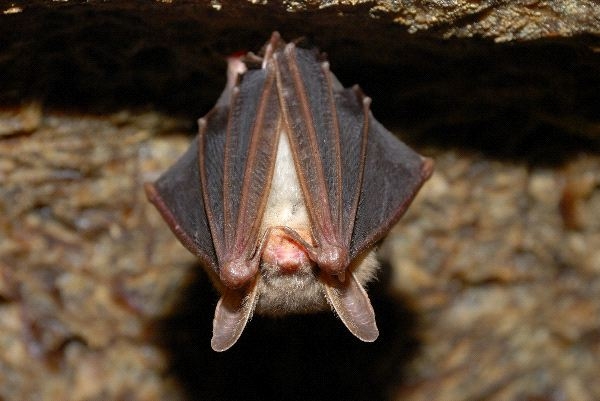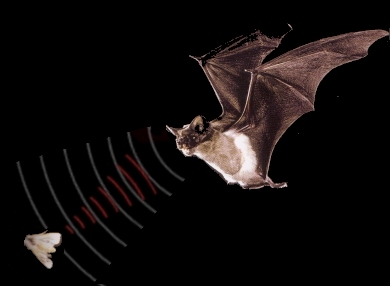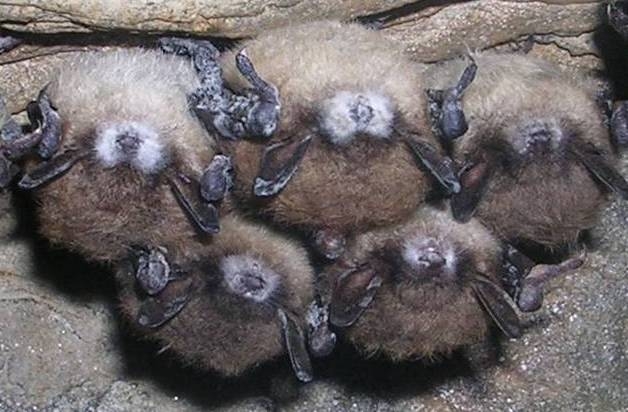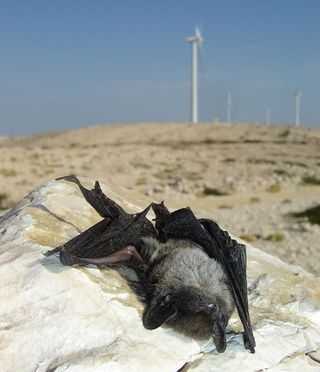Bats-Why We Should Care
 In addition to a lack of knowledge on the part of humans, many animals are misunderstood or maligned without reason due to myths and misinformation. One animal that has received a bum rap is the bat. In fact, along with hyenas, they are probably the most maligned and misunderstood animals in the world. Considered by many to be nothing but rabies carriers, or scary creatures of the night that will tangle in your hair (pleeeease, that is a myth), the general public is not aware of just how beneficial these animals really are to our ecosystems, our economies and our health. We hope to dispel some of the myths here and guide you into looking upon bats a little more kindly. Even if you do not grow to love bats (as we do), there are very good reasons to respect them.
In addition to a lack of knowledge on the part of humans, many animals are misunderstood or maligned without reason due to myths and misinformation. One animal that has received a bum rap is the bat. In fact, along with hyenas, they are probably the most maligned and misunderstood animals in the world. Considered by many to be nothing but rabies carriers, or scary creatures of the night that will tangle in your hair (pleeeease, that is a myth), the general public is not aware of just how beneficial these animals really are to our ecosystems, our economies and our health. We hope to dispel some of the myths here and guide you into looking upon bats a little more kindly. Even if you do not grow to love bats (as we do), there are very good reasons to respect them.
Bats can be found all over the world, except for polar regions. They belong to the order Chiroptera, the second largest order of mammals in the world (rodents being the largest). Over 20% of mammals worldwide are bats and they are the only mammals that are capable of true powered flight over sustained distances. Other “flying” mammals, such as the flying squirrel do not actually fly, they simply glide. Bats range in size from the larger megabats which include the flying fox, found in Indonesia, with a six foot wing span (and weighing over 2 pounds) to the small microbats such as the diminutive Kitti’s hog-nosed bat, weighing a mere 2 grams and measuring up to 1.3” in length.
Up to 70% of bat species are insectivores, while the remaining species feast on a diverse diet that includes nectar, pollen, small fish and mammals, fruit and in the case of the well-known vampire bat, the blood of mammals (just as aside, vampires do not suck blood. They lap it up. Doesn’t that sound much more refined to the squeamish?).
 Bats hunt by using echolocation, which is the use of sound waves and echoes to determine the location of objects. To do this, they send out sound waves from their nose or mouth. As the sound waves hits an object it will produce and echo which bounces back to the bat’s ears. Bats are able to determine the location, size and shape of an object from these echoes.
Bats hunt by using echolocation, which is the use of sound waves and echoes to determine the location of objects. To do this, they send out sound waves from their nose or mouth. As the sound waves hits an object it will produce and echo which bounces back to the bat’s ears. Bats are able to determine the location, size and shape of an object from these echoes.
Bats are in deep trouble. In addition to other threats, they are dying at an alarming rate from an insidious disease called White Nosed Syndrome, which has killed millions of bats in the eastern United States and is spreading westward, they are facing one of the most accelerated and dire wildlife crises in the past 100 years. It is time that people understood just how beneficial bats are to us and just how devastating it would be should we lose them.
Why Bats Are So Important
- Bats play a critical role in controlling insect pests and are natural enemies of night-flying insects around the world. A single little brown bat can catch more than 1,000 mosquito sized insects in one hour. The 20 million Mexican free-tailed bats from Bracken Cave in TX eat approximately 200 tons of insects nightly.
- lf we lose our bat species, we increase the demand for chemical pesticides, jeopardizing whole ecosystems of other animal and plant species, and harming human economies.
- Bats pollinate plants and disperse seeds. More than 300 plant species in the Old World tropics alone rely on the pollinating and seed dispersal services of bats, and additional bat-plant relationships are constantly being discovered. These bat-reliant plants provide more than 450 economically important products, valued in the hundreds of millions of dollars annually.
- Tropical bats are key elements in rain forest ecosystems, which rely on them to pollinate flowers and disperse seeds for countless trees and shrubs.
- In the wild, important agricultural plants, from bananas, breadfruit, and mangoes to cashews, dates and figs rely on bats for pollination and seed dispersal.
- Like margaritas? Thank a bat! Tequila is produced from agave plants whose seed production drops to one-3,000th of normal without bat.
- Desert ecosystems rely on nectar-feeding bats as primary pollinators of giant cacti, including the famous organ pipe and saguaro of Arizona.
- Contrary to popular myths, bats are not blind, do not become entangled in human hair, and seldom transmit disease to other animals or humans.
- Bat droppings (guano) in caves support whole ecosystems of unique organisms, and are a popular garden fertilizer.
- An anticoagulant from vampire bat saliva is being used to prevent strokes in human patients.
What is the truth about bats and rabies? - Like most mammals, bats can contract rabies; however, the vast majority of bats are not infected, and even those that are normally bite only in self-defense and pose little threat to people who do not handle them. (This is the number one reason to enforce the “look but don’t touch” rule for all wildlife!). Only about 1% of bats actually contract the disease.
- ln the United States from 1995 through 2009, an average of two people per year have died of rabies associated with bats. Rabies is readily prevented by post-contact vaccination.
- The fear of rabies is far disproportionate to the actual risk. To put the risk in perspective: about 386,000 Americans are treated for dog bites each year and about 16 people die from the attacks. Yet we would never consider massive media campaigns suggesting that we eradicate our canine friends.
Long Island's Bats
Here on Long Island, the following species can be found: Little brown bat (Myotis lucifugus), big brown bat (Eptesicus fuscus), eastern red bat (Lasiurus borealis), tri colored bat (Pipistrellus subflavus), northern long-eared (Myotis septentrionalis), silver-haired (,Lasionycteris noctivagans), hoary (Lasiurus cinereus).
What are some causes to the decline of bat populations? What can be done?
Bats face dire threats. The top causes of bat population declines are habitat loss (including the closing of abandoned mines, which bats utilize for hibernation and roosting), pesticides, white nosed syndrome and wind turbines.
 Since 2006 an estimated 6.7 million bats have perished from White-Nosed Syndrome (“WNS”), a fungus that appears to have been introduced to North America from Europe (interestingly, bats in Europe seem to have developed an immunity to the disease). Discovered in New York in 2006, this epidemic is considered the worst outbreak of any type of wildlife disease in North American history and it has left entire colonies completely wiped out. In hibernating bats WNS affects the skin of bats, including the wings, causing them to wake up frequently during the winter, eating up precious fat reserves and energy. These bats often have white fuzz around their muzzles, giving the fungus its name. Sadly, 70 to 90% of bats (and in some cases 100%) in an affected hibernation area will be killed once WNS invades their sanctuary. To date, scientists, biologists and universities are seeking out the means to control this deadly disease as it spreads westward.
Since 2006 an estimated 6.7 million bats have perished from White-Nosed Syndrome (“WNS”), a fungus that appears to have been introduced to North America from Europe (interestingly, bats in Europe seem to have developed an immunity to the disease). Discovered in New York in 2006, this epidemic is considered the worst outbreak of any type of wildlife disease in North American history and it has left entire colonies completely wiped out. In hibernating bats WNS affects the skin of bats, including the wings, causing them to wake up frequently during the winter, eating up precious fat reserves and energy. These bats often have white fuzz around their muzzles, giving the fungus its name. Sadly, 70 to 90% of bats (and in some cases 100%) in an affected hibernation area will be killed once WNS invades their sanctuary. To date, scientists, biologists and universities are seeking out the means to control this deadly disease as it spreads westward.
 Another threat facing bats are wind turbines. Many people have heard of the threat to birds from these structures, but surprisingly, bats are impacted more often than birds and its estimated that tens of thousands perish each year. While alternative energy is critical to our future, it is just as critical that those planning wind facility sites collaborate with conservation organizations so that wildlife and habitat is not negatively impacted. For the past decade or so, scientists and conservation partners have collaborated on research and studies as they work together to combat this issue.
Another threat facing bats are wind turbines. Many people have heard of the threat to birds from these structures, but surprisingly, bats are impacted more often than birds and its estimated that tens of thousands perish each year. While alternative energy is critical to our future, it is just as critical that those planning wind facility sites collaborate with conservation organizations so that wildlife and habitat is not negatively impacted. For the past decade or so, scientists and conservation partners have collaborated on research and studies as they work together to combat this issue.
For more Information, and to find out how you can help bats, check out the links below
White Nosed Syndrome- a comprehensive collaborative website with information about this devastating disease.
White Nosed Syndrome Fact Sheet- produced by the United States Fish and Wildlife Service
Organizations Helping Bats
Bat Conservation International: Bat Conservation International is conducting and supporting science-based conservation efforts around the world. Working with many partners and colleagues, these innovative programs combine research, education and direct conservation to ensure bats will be helping to maintain healthy environments and human economies far into the future.
Fun Stuff
What Does the Bat Say: Wonderful video produced by 3rd graders about bats!

